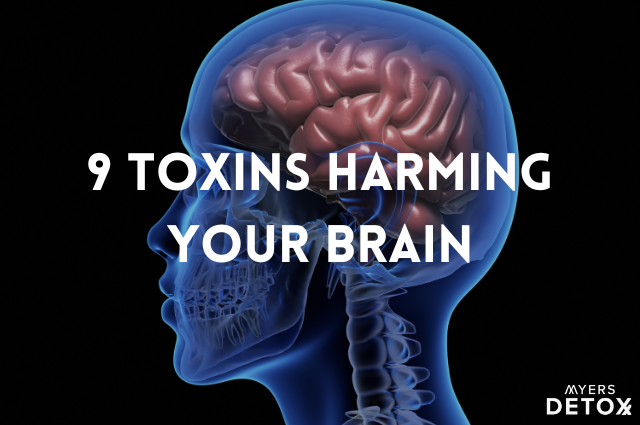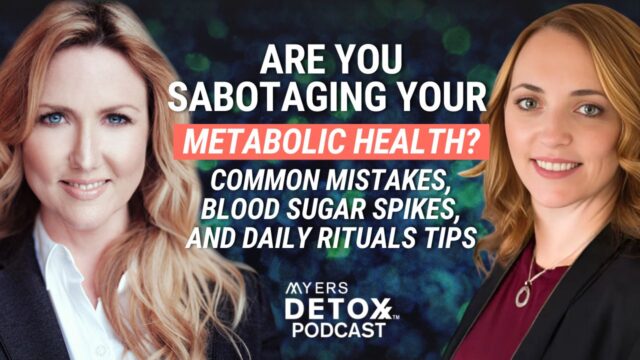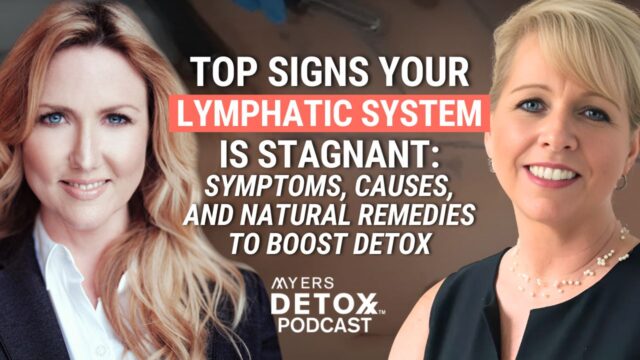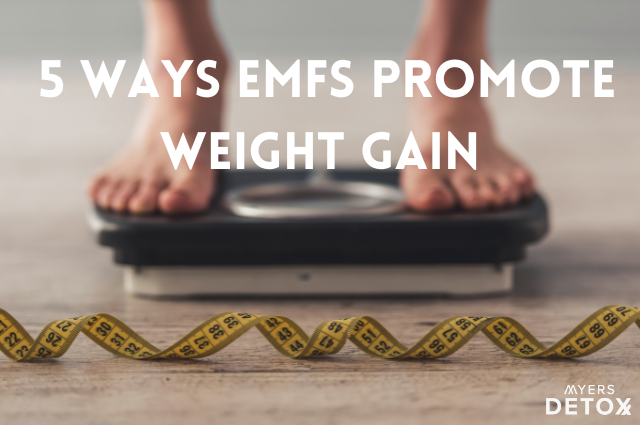It’s normal to forget a thing or two as you age, and brain fog can hit you at any time in life, but what if the very resources you’re using to look and feel younger are actually making you age?
The food you eat, the water you drink, and the personal care items you go to in order to feel your best may be laced with toxic metals. Yes, even filtered water and organic foods can contain these toxic compounds, and the personal care industry is absolutely flooded with them.
Heavy metals target your nervous system and brain, and unless you know how to mitigate and manage your toxic load, even your best intentions may be working against you.
In this article, we’ll discuss:
- How heavy metals can target your brain and nervous system
- The hidden dangers of cosmetics (hint: there are heavy metals you need to know about)
- Why symptoms like brain fog, memory issues, and cognitive decline may be rooted in your food, water, and cosmetic routine
- The most impactful thing you can do to detox heavy metals, feel your best and look your best—at the same time.
9 Heavy Metals To Watch Out For, And Where They May Be Hiding
Several heavy metals can be found in cosmetics, along with other everyday products. Below, we will review the six most common ones that find their way into your cosmetics bag.
#1 Aluminum
Aluminum may be one of the most well-known neurotoxins in the heavy metal family. Studies show that accumulation of this metal in the nervous system may lead to cognitive dysfunction and neurological diseases[5].
Unfortunately, aluminum is also one of the most common heavy metals in everyday goods, including cosmetics. In fact, unless your antiperspirant specifically says “aluminum-free,” you can bet that there’s aluminum in there.
You’ll also find aluminum in various cosmetics as a thickening or absorbent agent. According to the EWG, aluminum can be found in blush, bronzer, brow liner, concealer, eye liner, eye shadow, eyelash glue, and more[6].
In addition to cosmetics, aluminum may also be found in food additives, antacids, and in cans and cooking foil in its metal form[7]. You also breathe it in the air.
#2 Arsenic
People, young and old, can be affected by arsenic exposure. Studies show that children who have high levels of arsenic in their bodies show symptoms of impaired attention, working memory, verbal comprehension, and reasoning[8].
Once in your system, arsenic can cause detrimental changes to the physical structure of brain cells, with serious effects including cytotoxicity, DNA damage, and structural changes to chromosomes.
One of the most prominent mechanisms for arsenic-induced neurotoxicity is oxidative stress, as this heavy metal reduces the antioxidant defenses in your brain. Unfortunately, your brain is particularly at risk for oxidative damage due to its high energy requirements, which only adds to arsenic neurotoxicity[9][10].
Despite the harmful effects of arsenic, it’s still found in eye shadow, lotions, lipsticks, sunscreen, foundation, and nail polish. Other potential sources of exposure include nonorganic chicken and eggs, rice, drinking water, smoking, and polluted air[11][12].
#3 Tin
Despite being highly toxic, tin is widely used in several industries with few legal regulations. As a neurotoxin, tin passes your blood-brain barrier, causing oxidative damage and neuroinflammation, potentially leading to the development of neurodegeneration[13].
Tin is also a potent mitochondrial poison, reducing energy production needed to power the brain.
In the cosmetics industry, tin functions as a bulking agent, an abrasive agent, and an opacifying agent, giving liquid cosmetics that milky look. Outside of cosmetics, tin is widely used in food containers, particularly steel cans[14].
#4 Thallium
Studies show that thallium can target your neurons and incite oxidative damage, changing the physical properties of the cell and ultimately leading to mitochondrial dysfunction[15].
When applied topically, thallium is absorbed through the skin and mucous membranes and then widely distributed throughout the body, accumulating in the liver, kidneys, bones, and, you guessed it, the central nervous system.
Along with its oxidative qualities, thallium can also replace potassium in enzymatic reactions, which can have profound downstream effects on cellular functioning[16].
Thallium is used in the production of dyes and pigments, which is why we find it in several cosmetic products, including eyeliner, mascara, and eye shadow. You’ll also find traces of thallium in imitation jewelry, optical lenses, and batteries.
#5 Antimony
Antimony is a heavy metal that specifically targets cellular growth pathways, initiating apoptosis (cellular death) in neurons by halting cell cycle progression. Put simply, antimony is highly oxidative, targeting brain cells and poisoning them[17].
In animal models, antimony has been shown to alter neurological behavior and interfere with genes involved in the nervous system[18].
Antimony has been used in cosmetics since ancient times. In fact, Egyptian women used to use antimony to blacken their eyes. This practice is still used today with a product known as Kohl, a traditional cosmetic used in Asia and Africa[19].
Antimony is also added to textiles, ceramics, fireworks, enamels, plastics, pigments, and paper as a flame-retardant[20].
#6 Bismuth
Bismuth is another metal that has an affinity for the central nervous system, with toxicity eliciting a range of neurological symptoms, including delirium, psychosis, involuntary muscle twitching or jerking, confusion, memory loss, anxiety, depression, and personality changes[21][22][23].
In cosmetics, bismuth is used for pigmentation, which is why you’ll find this toxic metal in blush, powder foundation, eyeshadow, and bronzer. Bismuth is also commonly used in pharmaceuticals, glass, and ceramics[24].
I routinely find that women that use Bare Minerals makeup products, namely the powders and pressed powders have incredibly high levels of bismuth on their heavy metals test. I recommend avoiding this brand.
#7 Cadmium
Prolonged, low-dose cadmium exposure poses a serious risk for many individuals as this heavy metal is found throughout our food and water supply. While it’s well-known as a contaminant in cigarette smoke, many people don’t realize that cadmium is also widely found in plant-based foods such as wheat, rice, and potatoes. Furthermore, due to bioaccumulation, animals that feed on cadmium-toxic plants will also pose a risk.
Why is there so much cadmium in our food supply? It mostly comes down to fertilizers that are used to enhance yield[39].
The nervous system is the primary target for cadmium, as it hitches a ride into your nervous tissues via zinc and calcium transporters. Once it’s gained access to your nervous system, cadmium targets your mitochondria, disrupting energy production and increasing oxidatve stress. It also directly impacts the function of your neurotransmitters and their signaling pathways. As a result, prolonged cadmium exposure is suspected to be a contributing factor to neurological disease[40].
#8 Mercury
The impact of mercury on mood, behavior, and neurological health has been understood for centuries. In fact, Alice in Wonderland’s “The Mad Hatter” was fashioned after a very real condition caused by mercury poisoning that leads to changes in mood and personality, memory issues, insomnia, tremors, irritability, and more[41].
While mercury used to be a staple in cosmetics dating all the way back to Egyptian times, today, our most significant sources of exposure include dental amalgam fillings and fatty fish like mackerel and tuna[42].
The FDA does not allow mercury in personal care products. That said, some skin-lightening products have been found to contain mercury, so watch out for those[43].
#9 Lead
There are no safe levels of lead in the human body, and yet this is one of the most ubiquitous that we come into contact with daily. Trace amounts of lead can be found in cosmetics (lipstick is a big one), our food, and our water supply. The state of California takes lead contamination very seriously, which is why you’ll see Prop 65 labels on certain supplements and other potentially hazardous products[44].
Lead exposure is also a very real threat to people working in certain industries, like construction, where metal and lead-based paints are used [45].
This heavy metal is well-known to cause birth defects and reproductive harm, specifically targeting brain development. While children are at the highest risk for lead poisoning due to their small size, adults who are exposed to lead are certainly not in the clear.
Some of the neurological symptoms associated with lead exposure include difficulties in intelligence and learning, memory issues, poor executive functioning, challenges with attention, and mood disorders[46].
It’s also suspected that lead exposure in early life may increase the risk of neurodegenerative disease later in life, likely due to the cumulative effect of lead poisoning over time[47].
Cosmetics, Heavy Metals, and Your Brain
Many people are aware that heavy metals can be found in our food and water supply, but one of the sneakiest ways these toxins get into our bodies is through cosmetics.
While there are clear green flags you can look for with your food to ensure safety (non-GMO and organic certifications, for example), the cosmetics industry is a bit more tricky. Since they don’t have to follow the same guidelines as food, it’s much easier for toxic compounds to sneak into cosmetics, and heavy metals are one of the most common culprits.
Why are heavy metals lurking in your cosmetics?
In some cases, they’re part of what makes the pigmentation of colored cosmetics like lipstick, eyeliner, mascara, and eye shadow. Some make cosmetics sparkle and glitter. Others are part of thickening and bulking agents, and still, some are just residues from ingredient resourcing.
Regardless of how they got there, it’s important to understand that many cosmetic brands, even those considered “natural” or called “mineral” makeup contain some level of heavy metals.
But how exactly do heavy metals in your cosmetics end up producing symptoms like brain fog, memory issues, and cognitive decline?
Anything you put on your skin has the potential to be absorbed into your circulation. While our skin acts as a protective barrier to the outside world, it is quite permeable, and if particles are small enough, they can slip through and enter our circulation.
Once in circulation, these toxic compounds can cross the protective blood-brain barrier (BBB). Once through the BBB, they settle down in the fat and cells of your nerves and brain and accumulate in the tissues[1].
As you might imagine, the accumulation of metals in the nervous system creates a highly toxic environment, inducing oxidative damage, DNA damage and disrupting mitochondrial function (and energy production). And impairing enzymatic activity[2]. They even outright kill brain and nerve cells.
The result? On the milder side, you may experience symptoms like brain fog or mental fatigue; on the more serious side, however, excessive metal exposure may lead to neurological diseases and cognitive decline[3][4].
Look Great And Feel Even Better
While these metals can be found throughout our environment, the real issue arises when we come into contact with them daily. If the food you eat, the water you drink, or your cosmetics contain heavy metals, you’re silently giving yourself a dose of toxicity every single day.
And unfortunately, even if you have a high-quality water filter, clean cosmetics, and a diet that consists of organic, non-GMO foods, you’re still likely coming into contact with heavy metals.
Why?
Because they’re simply everywhere these days. We can mitigate our contact with them, but it’s impossible to avoid them completely.
Instead of throwing your hands up and feeling helpless, you can take control of your daily toxic load while also nurturing your cognitive health by simply making a practice of detoxifying heavy metals on a regular basis.
This is precisely why I formulated Ageless AF. Ageless AF not only targets heavy metals in your body to assist with their natural removal, but it also contains anti-aging ingredients to nourish and support your skin, hair, and nails for a more youthful appearance.* So you get to look good, while giving your brain the support it needs to remove unwanted toxins—it’s the ultimate two-for-one.
While I could have packed this product with any range of ingredients, I hand-picked four of the most well-researched nutrients out there to tailor this formulation specifically for beauty, anti-aging, and supporting toxin removal. The ingredients include: silica, selenium, hyaluronic acid, and biotin.
Silica (As Orthosilicic Acid)
For Ageless AF, I went with the highest quality silica available, orthosilicic acid (OSA).
What sets OSA apart is its incredible bioavailability, with double the absorption of any other form of silica and 500% more bioavailability than food sources.
Orthosilicic acid (OSA) helps facilitate the natural removal of toxins like heavy metals by attracting metals via valence to the charge of heavy metals. This even prevents metals from absorbing into the system.*
Studies show that orthosilicic acid (OSA) is particularly helpful in assisting with arensic aluminum, tin, thallium, cesium, antimony and bismuth toxicity [25][26].
Silica is also an important nutrient needed and required for optimal collagen synthesis, which plays a critical role in healthy skin and hair. You don’t want to make the mistake of taking collagen everyday and then skipping slilica, which is needed to absorb the collagen!
Collagen makes up the vast majority of your extracellular matrix that sits under your skin, giving it a tight and firm appearance. You can think of your ECM as the scaffolding holding up your outer skin layers[27].
Selenium
Selenium is another beauty plus detox powerhouse nutrient.
Studies show that selenium is especially helpful in supporting the natural detox of mercury, arsenic, thallium, and antimony, through a few different mechanisms[28][29][30].*
One of the most well-researched ways that selenium works is through metabolic reduction. In lay terms, this is where selenium traps a heavy metal, rendering it metabolically inert and, therefore, neutralizing its toxic effects[30][31].*
Selenium is also a powerful antioxidant, which assists in protecting against the oxidative damage caused by heavy metals[32]. In this way, selenium can play a vital role in skin health as it helps to fend off your skin’s most formidable enemy—oxidative stress.
Studies show that selenium can help protect your skin from UV radiation, the number one cause of skin aging. For this reason, selenium is also associated with helping to prevent premature wrinkles and fine lines while also supporting skin pigmentation[33][34].
Hyaluronic Acid
When it comes to skin moisture, no nutrient is more vital than hyaluronic acid. Hyaluronic acid assists with water and moisture retention in the skin, binding water molecules and allowing the skin to function optimally. It gives skin that plump, youthful appearance.
What are some signs of properly hydrated skin? Elasticity, resilience, and pliability—in other words, all the things that make skin look youthful[35].
And with around 50% of your body’s hyaluronic acid residing in your skin, this nutrient is a must-have if you want that youthful glow.
But hyaluronic acid isn’t just a beauty molecule. Studies show that it may also act as a chelating agent. If you’re unfamiliar, chelating compounds bind to other compounds in your body, helping with their removal. This activity of hyaluronic acid has been specifically studied for the aiding in the removal of toxins, which makes it an ideal addition to Ageless AF[36].
Biotin
The final nutrient in the Ageless AF formula is biotin. While this vitamin doesn’t directly affect heavy metal toxicity, it does wonders for hair, skin, nails and bones and is simply too important to leave out of any beauty product.
Research specifically focusing on biotin and hair health is abundant, with studies showing that one of the key features of biotin deficiency is hair loss, and that once this nutrient is replete, hair growth resumes[37].
While many of us focus on anti-aging treatments for our faces, around 37% of women also experience hair thinning as they age. Biotin is one of the most critical hair growth nutrients because it assists in synthesizing keratin, the primary protein making up hair follicles[37][38].
Takeaway
As you age, all kinds of “issues” may start to appear. Yes, your skin may begin to look a little less youthful, and your hair may sustain the same luster, but if you’re dealing with symptoms like brain fog and memory issues, it may not be the aging process at all.
In addition to the cosmetics you use, heavy metals are found in our soil (which means our food), our water, and everyday items like cleaning products, dishware, food containers, and so on.
While there’s no shame in wanting to look your best, you shouldn’t have to sacrifice your health to do it. Adding in a daily heavy metal detox can help keep those unwanted toxins at bay. Can you completely avoid heavy metals? At this point, likely not. But you certainly can get ahead of them accumulating and causing toxic effects in your body.
Up-level your beauty and cognitive health routine with Ageless AF and get the best of both worlds—anti-aging nutrients with the added benefit of heavy metal detox.
*These statements have not been reviewed by the FDA. The information herein is not intended to diagnose, treat, cure, or prevent any disease. Nor is it meant to replace or act as a substitute for speaking to a medical doctor and/or licensed health practitioner. Any products discussed are not intended to diagnose, treat, cure, or prevent any disease. They are not intended to replace any medication, medical test(s), or healing modality prescribed by your medical doctor. Please consult with your doctor before beginning a new supplement regimen.









